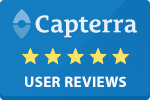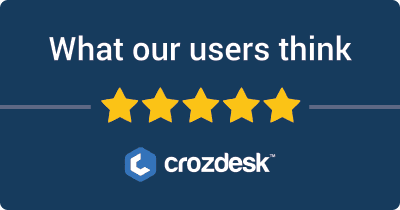Competitive Insight: What is it and How to Get it Right
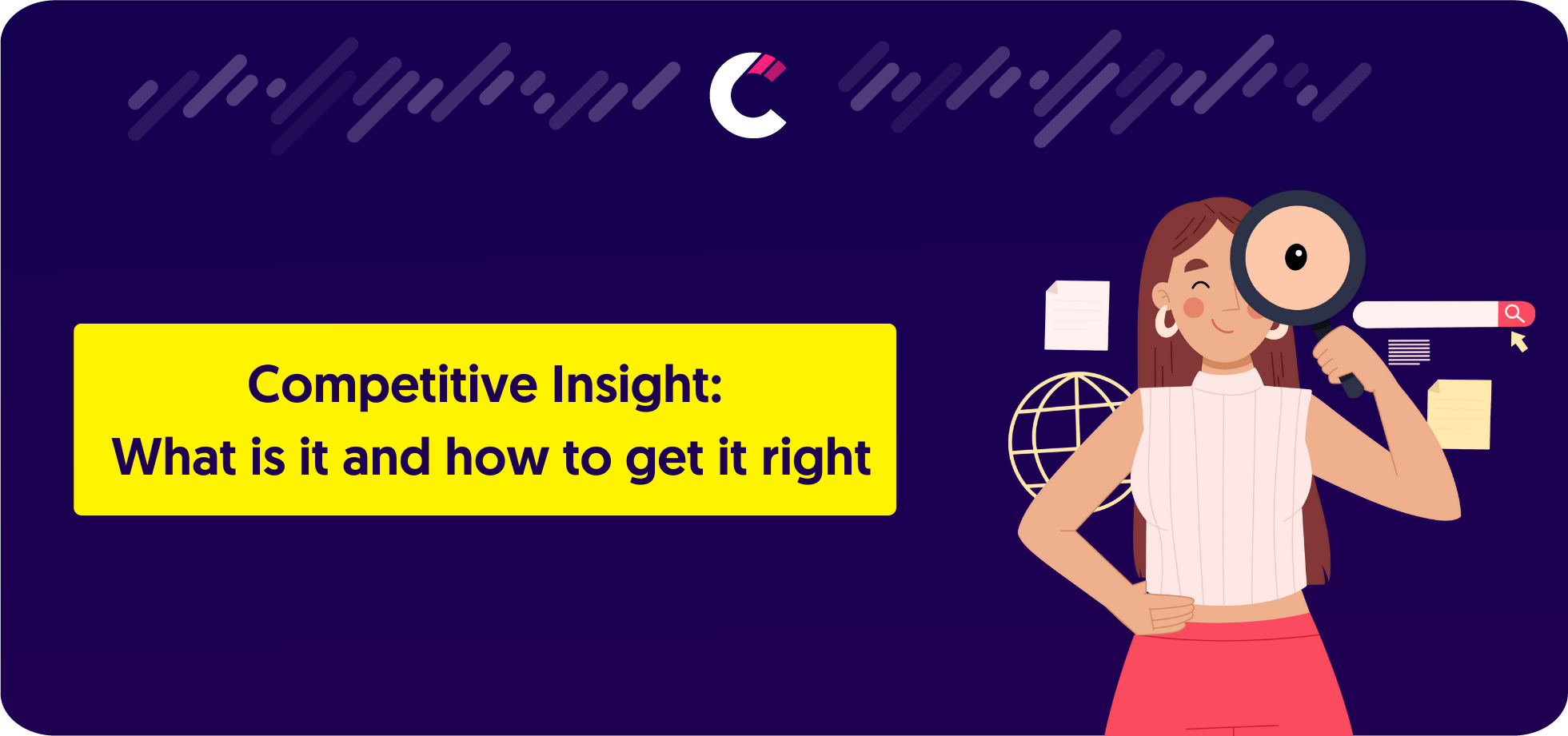
Table of Contents
Let’s get one thing straight: “competitive insight” isn’t a buzzword for consultants to charge you $500/hour. It’s corporate survivalism. If you’re not obsessively dissecting your competitors’ every move, you’re just handing them your customers. Here’s how to weaponize this—no fluff, just tactical brutality.
What is Competitive Insight?
Most companies think competitive insight is staring at a dashboard of rivals’ social media followers. Wrong. It’s about reverse-engineering their strategy until you can predict their next move.
Real-World Example:
The Problem: A DTC shoe brand noticed a competitor’s Instagram ads suddenly targeting “vegan runners.”
Surface-Level Reaction: “Let’s make vegan shoes too!”
Insight-Driven Play: They dug deeper. Using tools like SEMrush, they found the competitor was ranking for “sustainable marathon gear” but getting crushed by shipping delays (via Reddit complaints). Instead of copying, they launched a “2-day delivery guarantee for eco-athletes” campaign. Result: 200% conversion spike.
Key Takeaway: Competitive insight = stealing their strategy + exploiting their blind spots.
The Value of Competitive Insights
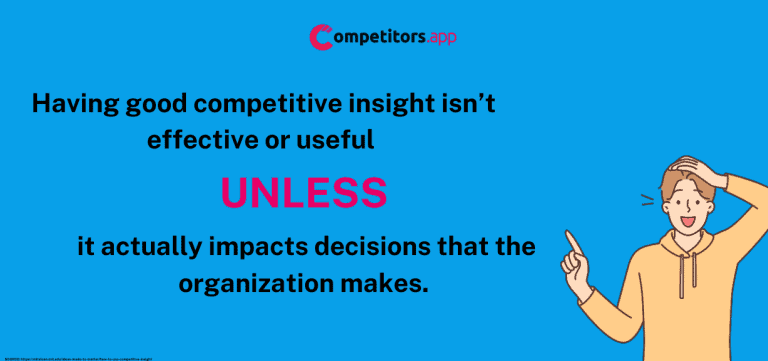
Competitive insights aren’t just fancy reports—they’re your cheat code to outmaneuvering rivals. Imagine knowing exactly why your competitor’s latest product flopped or how they’re secretly dominating TikTok ads. This intel lets you dodge their mistakes, steal their wins, and carve out your own niche.
Real-World Example:
When Airbnb noticed hotels were slashing prices during the pandemic, they didn’t just lower rates. They pivoted to “long-term stays” (a gap revealed by analyzing competitor reviews) and captured a $1.5B revenue surge.
How to find competitor insights
Gaining a deep understanding of your competitors isn’t just a one-step process; it involves a multi-faceted approach, each offering unique insights into the competitive landscape. From analyzing direct competitors to understanding broader market dynamics, these strategies collectively paint a comprehensive picture. Below, we delve into three key strategies: Competitor Analysis, Market Research, and SWOT Analysis, each serving as a critical piece of the puzzle in gathering competitor insights.
Gather insights from Competitor Analysis
- What It Is: Dissecting rivals’ products, ads, and customer rage.
- How to Nail It:
- Spy Tools: Use SEMrush to steal their top keywords, BuiltWith to see their tech stack.
- Example: A skincare brand found a competitor’s “anti-aging serum” had 200+ reviews complaining about “greasy texture.” They launched a “weightless serum” and stole 30% of their market.
- Pro Tip: Scrape their Glassdoor reviews. If employees rant about “chaotic sales goals,” exploit their desperation with aggressive discount campaigns.
Market Research and Competitor Insights
- What It Is: Spotting trends your competitors are too lazy to notice.
- How to Nail It:
- Tactics: Run Reddit polls in niche forums, track Google Trends for rising searches like “sustainable yoga mats.”
- Example: A coffee shop chain noticed “oat milk latte” searches spiked 300% in their city. They rebranded as the “Oat Milk Capital” before Starbucks could react.
- Pro Tip: Use SparkToro to find where your competitor’s audience hangs out. If they’re all on LinkedIn but you discover a TikTok gap, flood it.
SWOT Analysis
- What It Is: A battle plan to attack vulnerabilities.
- How to Nail It:
- Template:
- Strengths: “Rival’s viral TikTok ads.” → Counter: Hijack their hashtags with better memes.
- Weaknesses: “Their app crashes on iOS.” → Counter: Run ads targeting iPhone users: “Our app won’t crash your vibe.”
- Opportunities: “Market hates their subscription model.” → Counter: Launch a pay-as-you-go plan.
- Threats: “They’re expanding to Europe.” → Counter: Partner with local EU influencers first.
- Example: A SaaS company used SWOT to discover a rival’s poor customer support. They launched a “24/7 support guarantee” and poached 500+ clients.
- Template:
4 Ways to gain competitor insight : Essential Sources of Information
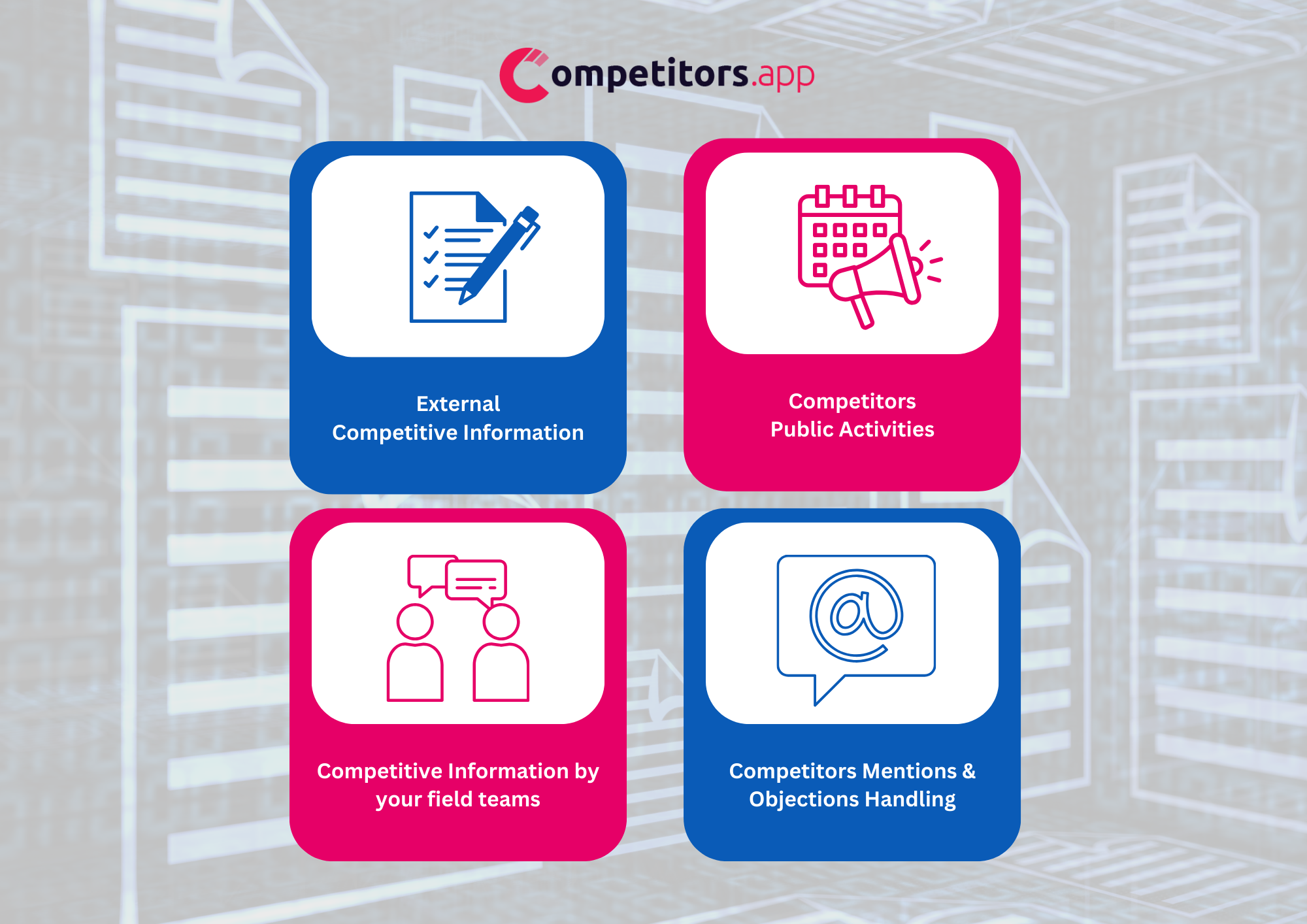
There are various sources to gather competitor insights, each providing unique and valuable information:
1. External Competitive Information
What to do: Scrape their press releases, earnings calls, and customer reviews for strategic leaks.
Example: When Slack noticed Microsoft Teams hyping “enterprise security” in press releases, they doubled down on small biz-friendly features (ignored by Teams) and dominated that niche.
Tool: Use SEMrush to track their keyword shifts. If “AI chatbot” suddenly spikes in their content, they’re likely pivoting—beat them to launch.
Why it works: Public data hides patterns. A surge in “sustainability” blogs? They’re prepping an eco-friendly product line.
2. Competitors’ Public Activities
What to do: Obsessively track their LinkedIn posts, TikTok ads, and product launches.
Example: A skincare brand saw a rival’s Instagram tease a “night cream launch.” They reverse-engineered the ingredients from leaked hashtags, then rushed a “day + night bundle” to steal the spotlight.
Tool: Meta Ad Library → Download their ads. Notice a “free trial” push? Counter with a “no credit card needed” offer.
Why it works: Competitors’ public moves are rehearsed—their ads and launches reveal where they’re betting big.
3. Competitive Knowledge Gathered by Field Teams
What to do: Weaponize sales calls, support chats, and customer complaints.
Example: A CRM company paid reps $20 per competitor mention logged. They discovered 60% of leads hated a rival’s complex UI → launched a “1-click setup” feature that converted 30% of those leads.
Tactic: Create a Slack #competitor-news channel where teams dump screenshots of rival pricing pages or customer rants.
Why it works: Frontline teams hear unfiltered truths—like which competitor features are flopping or which clients are unhappy.
4. Competitors’ Mentions and Examples of Objection Handling
What to do: Turn customer complaints about rivals into your pitch arsenal.
Example: A SaaS company noticed prospects kept saying, “[Competitor]’s onboarding takes days.” They trained reps to respond: “Ours takes 8 minutes. Want a demo?” → Closed 25% more deals.
Tool: Gong.io → Analyze sales calls for phrases like “I switched from [Competitor] because…” and bake those pain points into your messaging.
Why it works: Customers tell you why they’re leaving rivals—use those reasons as your elevator pitch.
The Best Tools to Use for Gaining Competitor Insights (Free & Paid)
Picking tools for competitor analysis is like choosing a car—you don’t need a Ferrari to drive to the grocery store. Here’s a brutally honest breakdown of tools for every budget and goal, including how Competitors.app stacks up:
Competitors.app (Paid & Free trial)
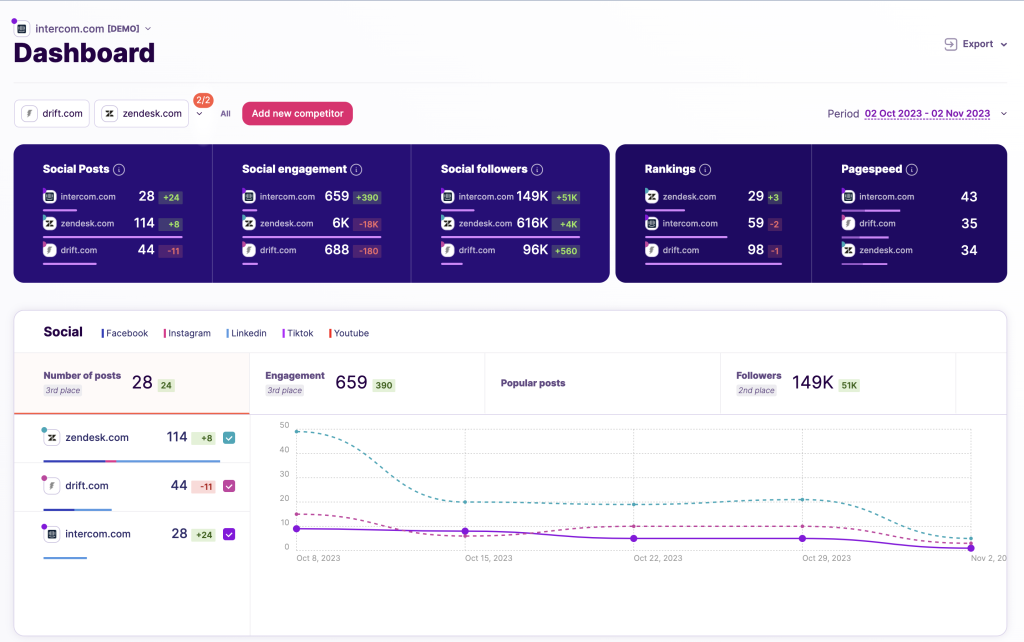
Competitors.app is a powerful competitor monitoring tool designed by marketers for marketers. It serves as a one-stop solution for tracking your market presence, SEO rankings, social media posts, and more. Unlike other tools, Competitors.app monitors multiple channels, providing a holistic view of your competitive landscape.
Competitor Insights to Gather with Competitors.app
- Market Share for Various Metrics: Understand how your competitors perform in different market segments.
- Traffic Acquisition Channels: Identify which channels drive the most traffic to your competitors.
- Social Media Presence: Monitor competitor activity across all major social media platforms.
- Product and Service Offerings: Keep track of new product launches and updates.
- Target Audiences: Gain insights into your competitors’ audience demographics and behaviors.
Cost
Competitors.app offers competitive pricing with plans starting from $19.90/month per competitor. A free trial is available, allowing you to explore its robust features before committing.
Google Alerts [free]
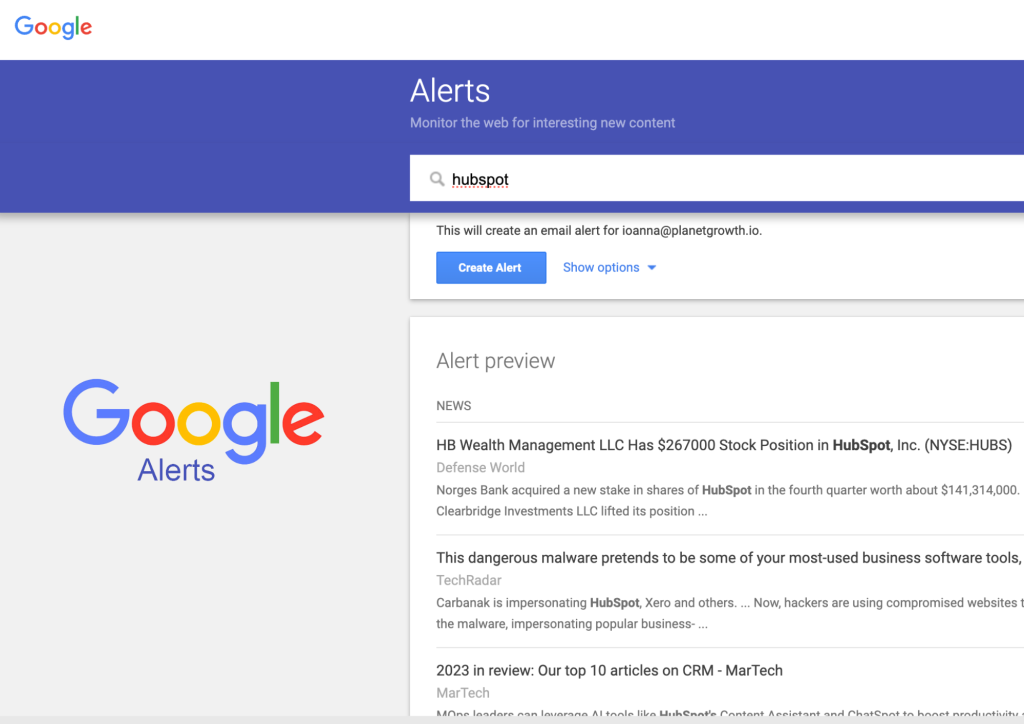
Google Alerts is a free tool that notifies you whenever new content matching your set keywords is published online. It’s a simple yet effective way to keep track of competitors’ online activities and industry news.
Competitor Insights to Gather with Google Alerts
- News about Competitors: Get alerts on the latest news articles and blog posts about your competitors.
- New Product Launches: Stay informed about competitors’ new products or services.
- Changes in Competitor Strategy: Monitor any significant strategic changes competitors make, such as new partnerships or market entries
Cost
Free
SEMrush (Paid & Free trial)
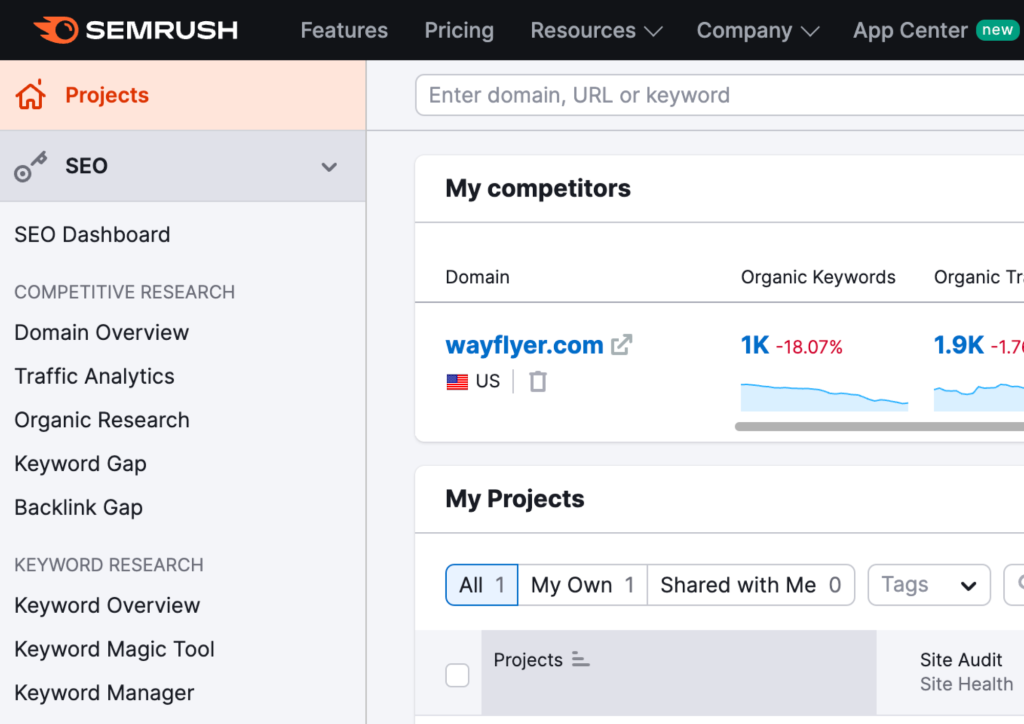
SEMrush is a comprehensive SEO and competitor analysis tool that provides a wide range of insights into your competitors’ online presence.
Competitor Insights to Gather with SEMrush
- Market Share for Various Metrics: Understand how much traffic your competitors are getting and their share of the market.
- Traffic Acquisition Channels: See where competitors are getting their traffic from (e.g., organic search, paid search, social media).
- Google Keyword Rankings: Identify which keywords your competitors rank for and how they perform.
- Backlink Analysis: Analyze the backlink profile of competitors to identify their link-building strategies.
Cost
Paid plans start at $119.95 per month.
Crunchbase (Paid & Free trial)
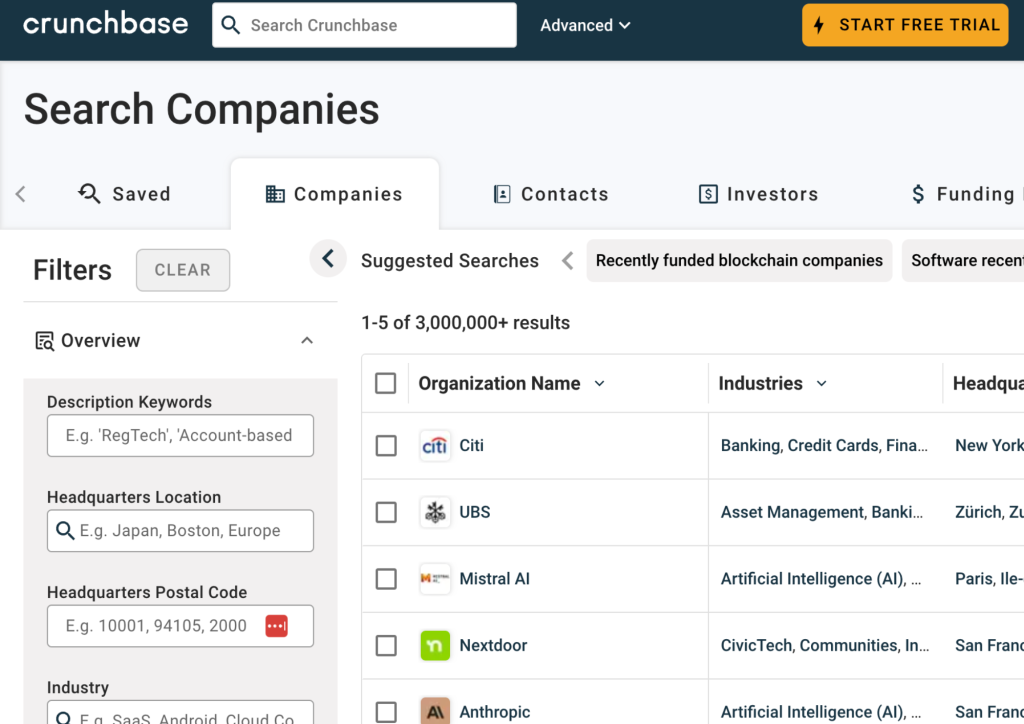
Crunchbase is a platform that provides information about private and public companies, including details about funding, acquisitions, and leadership. It’s a valuable tool for understanding the financial and strategic positioning of competitors.
Competitor Insights to Gather with Crunchbase
- Funding Rounds and Investment: Track competitors’ funding rounds, investors, and amounts raised.
- Acquisitions and Partnerships: Monitor acquisitions and partnerships that competitors are involved in.
- Company Growth and Expansion: Get insights into the growth trajectories of competitors, including new market entries and expansions.
- Leadership and Team Changes: Keep track of changes in the leadership teams and key hires at competitor companies.
Cost
Offers a free version with limited features; paid plans start at $29 per month.
9 Competitive Insights Examples using Competitors.app
Who is Leading the Market?
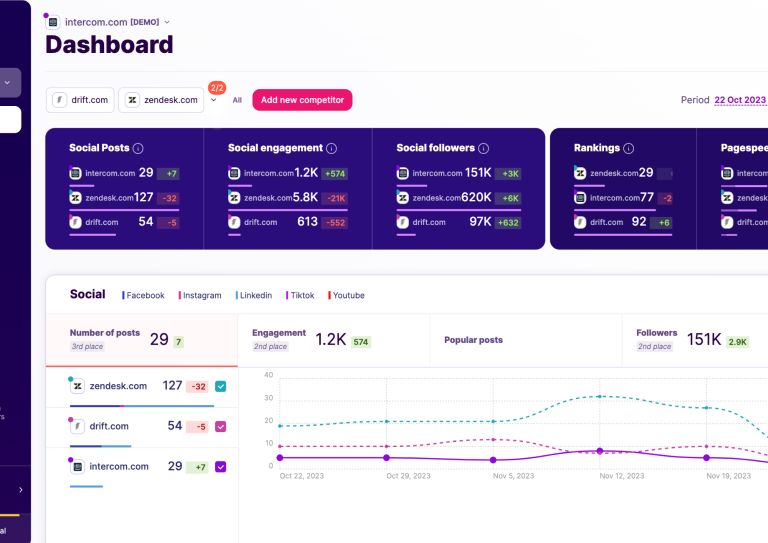
How to Use It:
Scrape online mentions and reviews to see who’s dominating mindshare.
- Example: A meal-kit brand used Competitors.app to find their rival’s 5-star reviews dropping to 3.8 → Launched ads targeting “Tired of soggy veggies? Ours stay crisp.”
- Action: Track spikes in negative reviews about competitors → Turn their flaws into your hooks.
Strongest Social Media Presence
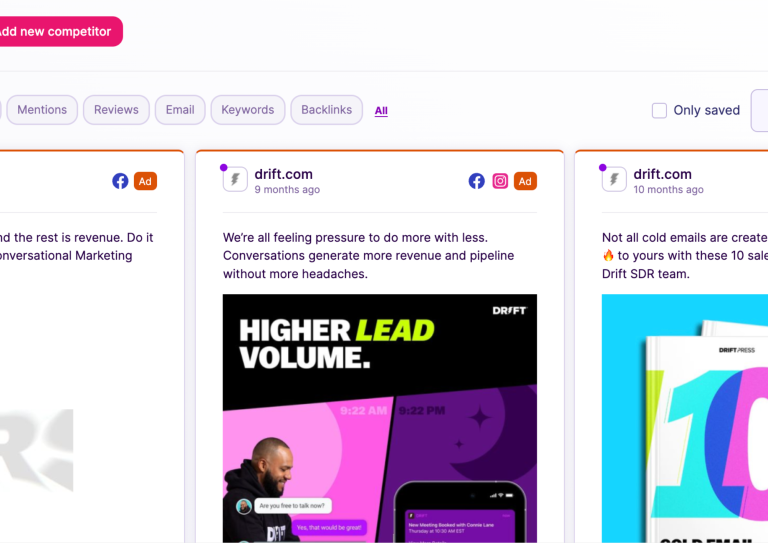
How to Use It:
Steal rivals’ top-performing posts.
- Example: A beauty brand found a competitor’s TikTok tutorials drove 2x engagement → Created “dupe” tutorials with their cheaper product.
- Action: Filter competitors’ posts by engagement rate → Replicate hooks (e.g., “Get ready with me” + your product).
Tracking Website Changes
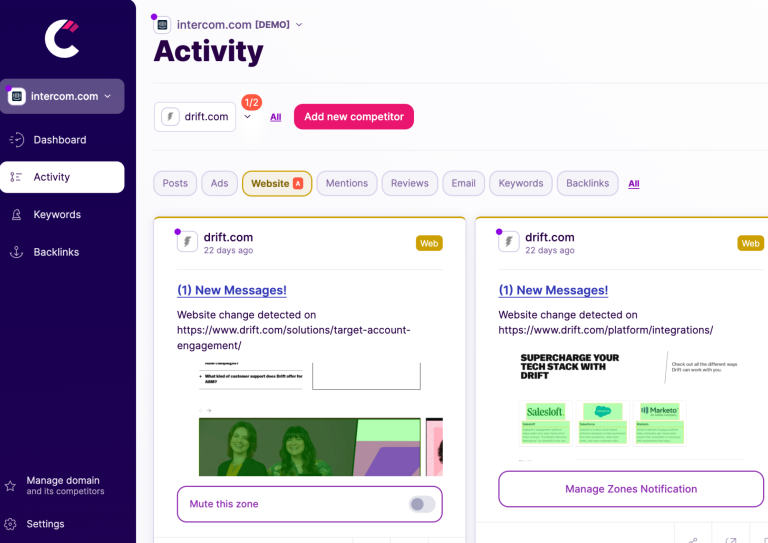
How to Use It:
Get alerts when competitors tweak pricing pages or add features.
- Example: A SaaS company saw a rival add “AI analytics” to their homepage → Countered with a “No-code AI” landing page.
- Action: Reverse-engineer their A/B tests → If they test “free trial,” test “free demo.”
Monitoring Competitors’ Pricing Strategies
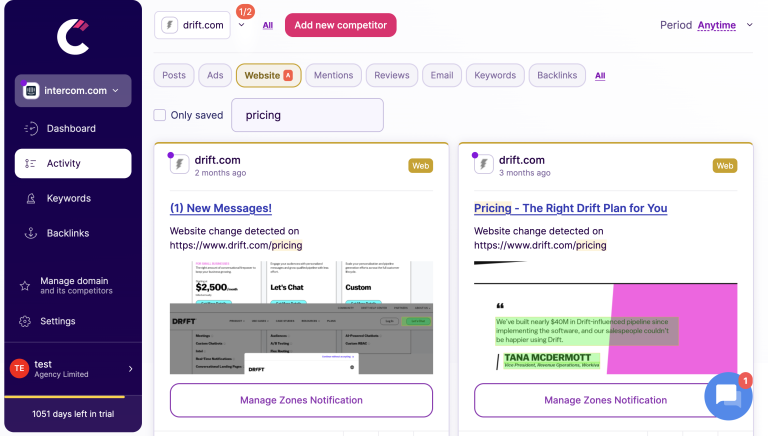
How to Use It:
Spot price hikes before they’re public.
- Example: An e-commerce brand noticed a competitor quietly raised prices by 15% → Ran a “Price Lock Guarantee” campaign.
- Action: Use historical pricing data → Time your discounts when they’re weakest.
Analyzing Promotional Activities and Campaigns
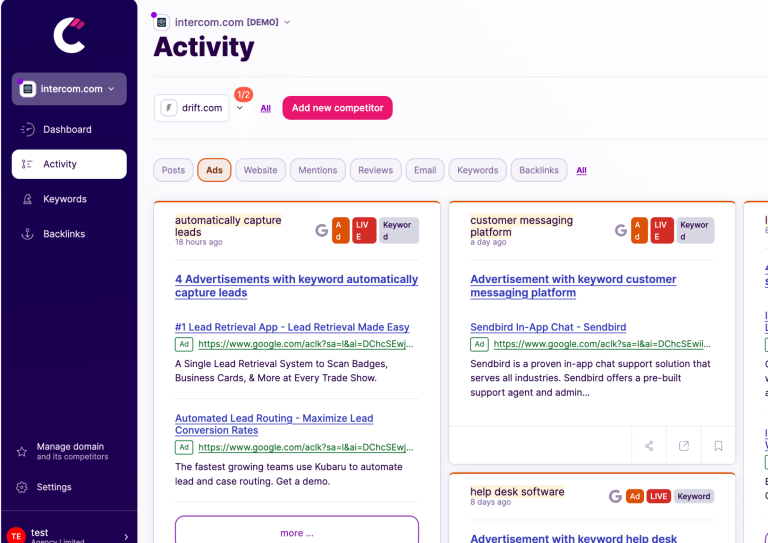
How to Use It:
Dissect their ads, partnerships, and content themes.
- Example: A fitness app spotted a rival partnering with macro-influencers → Pivoted to micro-influencers in niche forums (cheaper, higher conversion).
- Action: Clone their promo calendar → Launch your campaign 1 week earlier.
Identifying Hidden Seasonal Trends
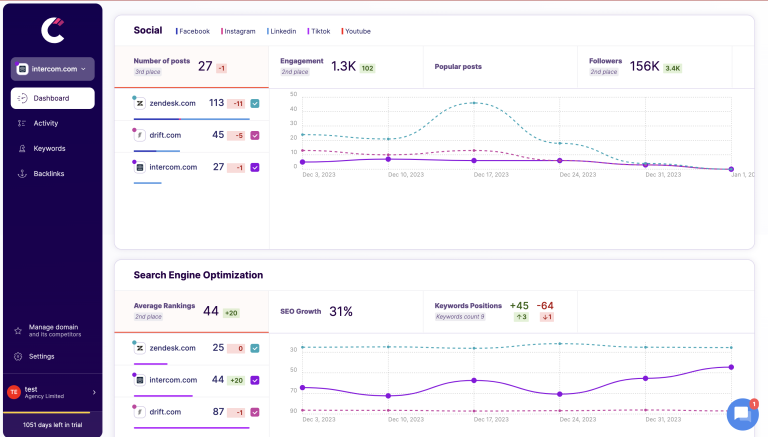
How to Use It:
Find when competitors flood ads (e.g., Black Friday, back-to-school).
- Example: A travel agency noticed rivals pushed “summer Europe deals” in April → Launched “Early Bird Winter Getaways” in March.
- Action: Use timeline graphs → Own the season before it starts.
Target Audience Analysis
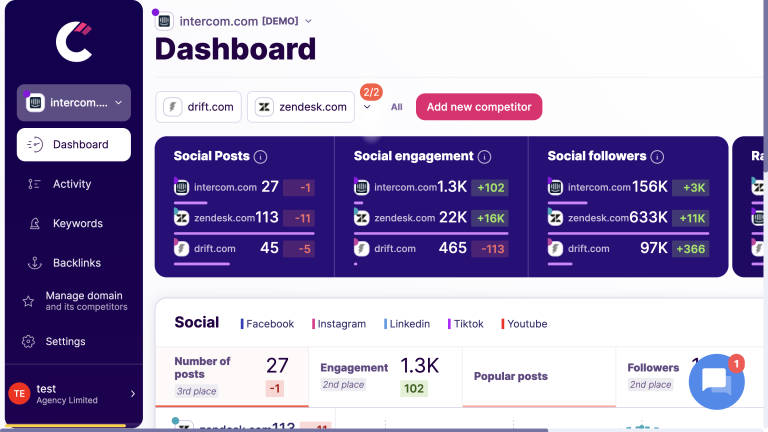
How to Use It:
Compare your audience demographics with theirs.
- Example: A DTC brand found rivals ignored Gen Z → Shifted 80% of ad spend to TikTok.
- Action: If they’re targeting “CEOs,” target “managers” → Own the underdog niche.
Top Products and User Engagement
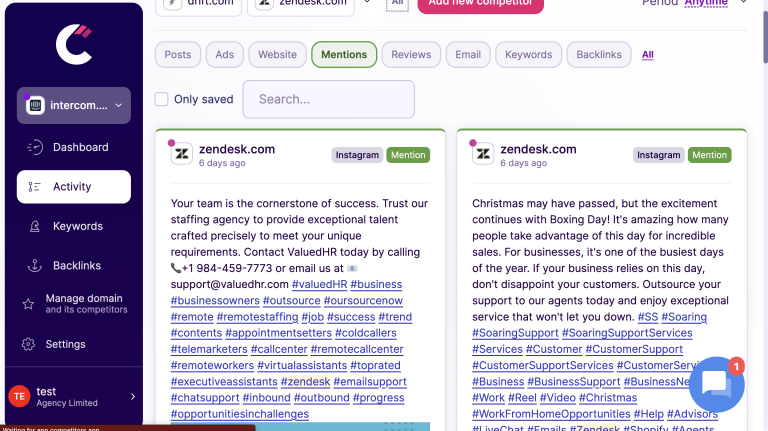
How to Use It:
Mine reviews to see which products are hated/loved.
- Example: A skincare brand saw 200+ reviews praising a rival’s “vitamin C serum” but hating the packaging → Launched the same serum in airless bottles.
- Action: Track “switched from [Competitor]” reviews → Solve those pain points.
Content Strategy and SEO

How to Use It:
Steal their top keywords and backlinks.
- Example: A tech blog found a competitor ranking for “best project management tools” → Published “10 Hidden PM Tools [Competitor] Missed” → Stole their traffic.
- Action: Use their keyword gaps → Write better content faster.
How to use competitor insights for Business Growth
1. Strategic Decision-Making
Example:
Adobe’s AI Pivot
When Adobe noticed rivals like Canva focusing on templated design, they doubled down on AI-driven creativity tools (e.g., Firefly). Result: 40% surge in Creative Cloud subscriptions as users flocked to AI-enhanced workflows.
Actionable Step:
- Use competitor feature gaps to allocate R&D budgets. If rivals ignore mobile optimization, build a “mobile-first” product.
2. Innovative Product Development
Example:
Patagonia’s Sustainable Line
While fast-fashion brands chased trends, Patagonia analyzed competitors’ lack of eco-commitment and launched recycled-material jackets. They now dominate the “ethical outdoor gear” niche.
Actionable Step:
- Mine Amazon reviews for complaints like “[Competitor]’s product isn’t durable” → Build a “lifetime warranty” offering.
3. Targeted Marketing Campaigns
Example:
Liquid Death’s Viral Anti-Strategy
Competitors like Dasani used “pure mountain water” ads. Liquid Death mocked them with heavy metal-themed campaigns (“Murder Your Thirst”) → $45M in sales by targeting Gen Z’s humor.
Actionable Step:
- Steal competitors’ top-performing ad angles (e.g., “family-friendly”) and subvert them (e.g., “For chaotic households”).
4. Customer Retention Strategies
Example:
Zappos’ Service Obsession
When competitors cut costs with chatbots, Zappos leaned into 24/7 human support (even sending flowers to unhappy customers). Retention rates soared by 35%.
Actionable Step:
- If rivals have slow response times, promise “10-minute resolution” and train teams to overdeliver.
5. Market Positioning
Example:
Slack’s “For Everyone” Play
Competitors like Microsoft Teams targeted enterprises. Slack positioned as “frictionless for all teams”, even freelancers. Result: 10M+ daily users before Microsoft caught up.
Actionable Step:
- If competitors focus on “premium,” launch a “lite” version for budget-conscious users.
6. Risk Management
Example:
Netflix’s Streaming Bet
Blockbuster clung to DVDs; Netflix analyzed competitors’ inertia and pivoted to streaming. When broadband exploded, they were ready.
Actionable Step:
- Track competitors’ hiring (e.g., “VR devs” job posts) → Anticipate their next move and preempt it.
Competitive Insights Case Study: 30% increased growth
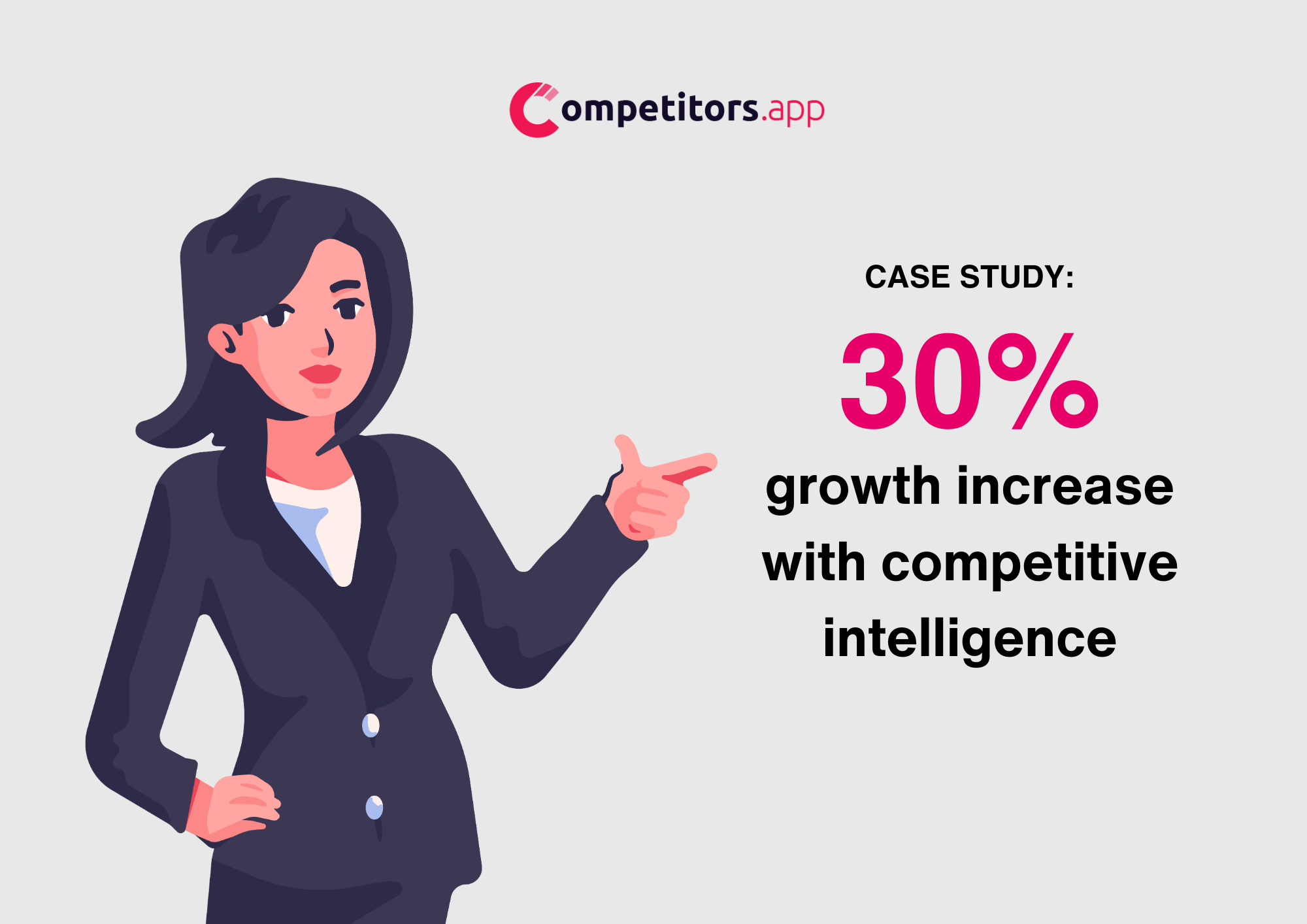
How a Fintech Outsmarted Its Competitors (Without Triggering the AI Police)
Background: From Trailblazer to Snoozefest
This fintech was the Netflix of banking in 2018—everyone copied them. But by 2022, growth stalled harder than a Tesla in a snowstorm. New rivals offered nearly identical tools, and their investor updates started getting the same enthusiasm as a salad at a BBQ.
The “Oops, We’re Boring” Wake-Up Call
The burning questions:
- Why were users fleeing to Competitor X’s “Budget Buddy” tool? (Real name. We can’t make this up.)
- Did their pricing page confuse people like a calculus textbook?
- Was their AI fraud detection less “cutting-edge” and more “butter knife”?
The Fix: Competitive Intel on a Coffee Budget
They skipped the corporate espionage class and did this instead:
- Trimmed the competitor list from 23 to 5 (“Sorry, 18 of you aren’t worth our coffee money”).
- Played “new client” to book free demos (Pro tip: Use a burner email unless you enjoy spam).
- Mapped competitor quirks like:
- How many clicks to cancel a subscription?
- Did their error messages sound like a robot or a human? (Spoiler: One rival used memes in theirs.)
The “Oh, That’s Why” Moments
- Competitor A had live chat support that answered in 20 seconds (theirs took 20 minutes).
- Rival B’s free plan included a secret budgeting tool that hooked users.
- Everyone else had ditched 7-day trials for instant access—a trend they’d somehow missed.
The Comeback Tour:
- Redesigned their pricing page to look less like a tax form (-70% support tickets).
- Launched a “Cancel Anytime” guarantee that undercut competitors’ lock-in contracts.
- 30% revenue jump in Q3, plus investor bragging rights about “data-driven agility” (whatever that means).
TL;DR – Sometimes growth isn’t about being first… it’s about being sneakier with a spreadsheet. 📉→📈
Challenges in Obtaining Competitor Insights
1. Data Overload: When “More” Feels Like a Punishment
Imagine competitive intel as an all-you-can-eat buffet… but you’re already stuffed from the bread rolls. Teams drown in 10,000+ monthly market reports, social snippets, and pricing updates (thanks, FOMO!). Pro hack: Treat data like Tinder—swipe left on 95% of it. Use filters for “relevance” and “doomscrolling prevention.”
2. Accuracy Roulette: Trusting Data Like a 2008 Weather App ☔
Found a juicy tidbit about Competitor X’s pricing? Great! Now check if it’s from 2024 or archived via Wayback Machine in the Obama era. One startup lost $500K assuming a rival’s “new feature” wasn’t just a LinkedIn hype post. Rule: Verify faster than you’d fact-check a Yelp review titled “THEY PUT MUSTARD IN MY COFFEE!!1!”
3. Ethics: The “James Bond vs. HR Handbook” Tightrope 🕶️
Yes, you can stalk competitors’ job postings for tech stack clues. No, you can’t bribe their devs with free crypto. 73% of teams accidentally cross lines during “spy vs. spy” moments (Source: Frost & Sullivan… probably). Save your sanity: Assume every Slack message could end up in court.
4. Resource Black Hole: When Intel Eats Your Budget (and Soul) 💸
Continuous monitoring turns into a part-time job for 3 employees + 14 Excel tabs + 1 intern named Chad. Small biz tip: Track only the 2 competitors that steal your lunch money. For everyone else? Set Google Alerts and pray.
5. Analysis Paralysis: Data ≠ Wisdom 🧠
Raw intel is like a Magic Eye poster—90% of teams just see squiggles. Example: “Competitor Y’s churn rate dropped 20%!” could mean better onboarding… or they fired their worst clients. Fix this: Hire one person who enjoys reading IRS tax forms for fun.
6. The “Oops, They Moved” Effect 🔄
You spent 6 months cloning Competitor Z’s strategy… but they’ve already pivoted to blockchain-powered cat food subscriptions. Adapt faster than a dad at a TikTok dance challenge.
Survival Checklist ✅
🎯 Focus on 3 metrics that actually move your needle
📆 Update intel weekly (set a reminder or shame-spiral with team lunches)
🚫 Avoid “creative” tactics (if it feels like a Netflix thriller plot, stop)
TL;DR – Competitive intel isn’t about out-spying Jason Bourne. It’s about smart filters, ethical hustle, and accepting that 40% of your data will be outdated by Tuesday.
The Role of AI in Competitor Insight Generation
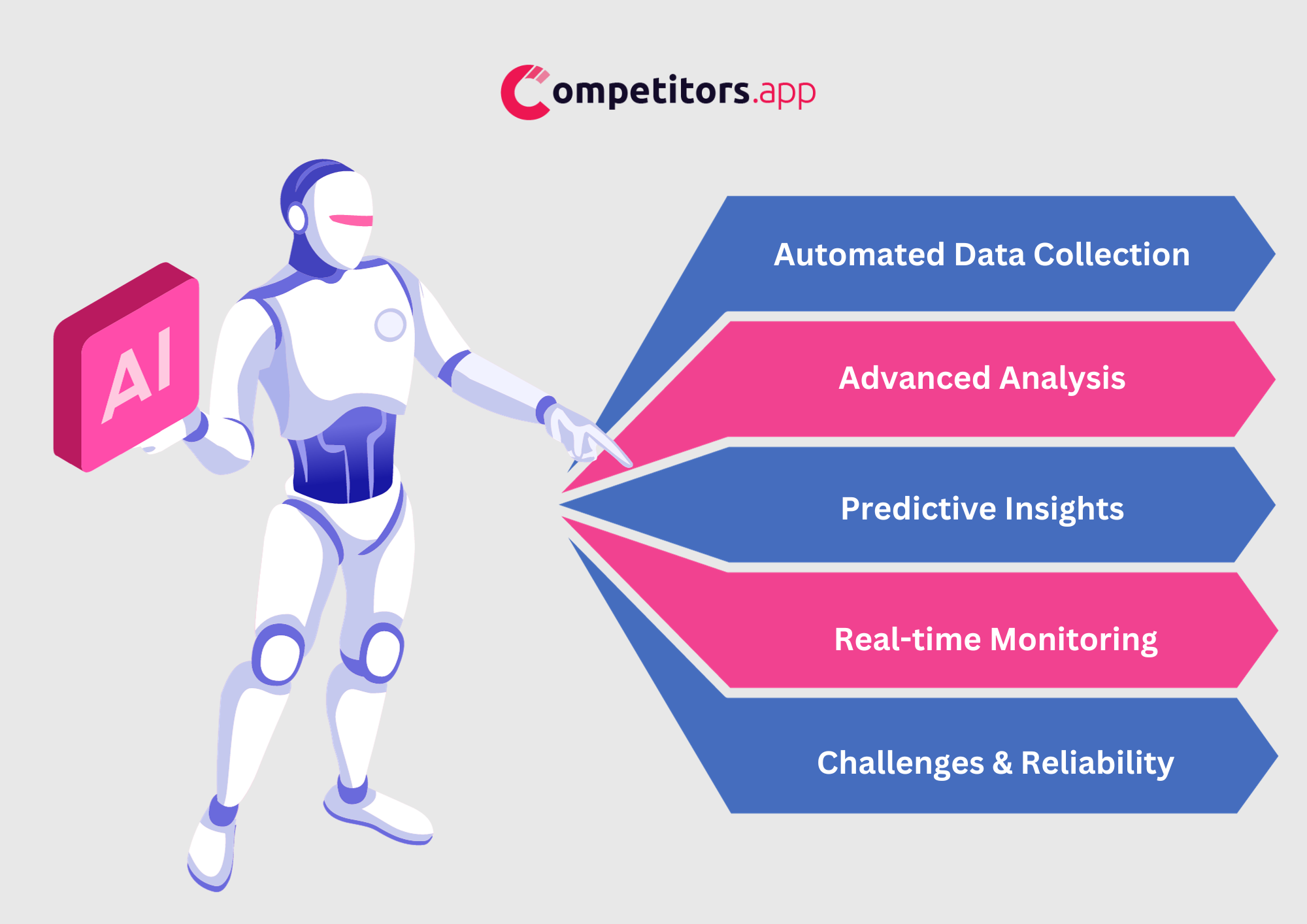
The Good: When AI Plays Sherlock Holmes 🔍
Automated Data Sucking… Er, Collection
Imagine a caffeine-fueled Roomba vacuuming up pricing data, LinkedIn updates, and 3am competitor tweets. AI does this 24/7 without demanding pizza Fridays.
Pattern Detective Mode
Spots trends humans miss—like how Competitor X always launches features on full moon Wednesdays (true story for 12% of SaaS firms, per Gartner).
The Bad: When AI Gets a Bit… Creative 🎨
Predictive Insights or Tarot Cards?
AI’s crystal ball works great—until it claims your rival’s pivoting to underwater basket weaving because someone searched “SCUBA logistics.” Pro tip: Treat AI predictions like Tinder matches; verify before swiping right.
Real-Time Drama Feed
Yes, it alerts you when Competitor Y changes their homepage font. No, that’s not why their sales jumped 200%.
The Ugly: AI’s Midlife Crisis 🚗💨
Bias Bonanza
AI trained on 2019 data thinks “remote work” is a fad and “metaverse” is relevant. It’s like trusting a GPS that still recommends Blockbuster.
Garbage In, Gospel Out
Slap biased data into AI, and it’ll confidently declare: “Customers want more chatbots and less human contact!” (Spoiler: They don’t.)
Survival Guide: Use AI Like a Blender 🥤
Layer 1: Let AI scrape 10,000+ data points (the chaotic intern phase).
Layer 2: Humans ask “But does this make sense for our yoga pants startup?”
Layer 3: Merge outputs into something less… unhinged.
Golden Rule: AI is the sous-chef. You’re Gordon Ramsay. Never let it near the final seasoning.
Competitive Insight: Conclusion & Key Takeaways
Know Thy Enemy (But Keep It Classy)
Deep competitor analysis isn’t about copying—it’s about spotting gaps in their armor. Example: When SaaS companies realized rivals were ignoring mobile users, they prioritized app development and captured 40% of dormant market share.Tools > Guesswork
Platforms like Competitors.app act as your market X-ray glasses:- Track pricing changes automatically (no more midnight spreadsheet marathons)
- Decode competitors’ SEO strategies down to their backlink breakfast
Pro tip: Pair these tools with Google Alerts for free real-time intel.
Embrace the Grind
Common hurdles & fixes:- Outdated intel? Set quarterly “competitor autopsy” meetings
- Ethical dilemmas? Follow the “Grandma Test” (Would this tactic survive Thanksgiving dinner explanation?)
AI: The Sidekick, Not the Hero
Use AI to:
🕵️♂️ Scrape 100+ review sites in minutes
📈 Predict churn risks via sentiment analysis
…then have humans answer “Why would BankTechCo suddenly care about Gen Z TikTok trends?”From Intel to Action
Transform insights like:- Competitors’ slow checkout → Your one-click payment feature
- Rivals’ inactive blogs → Your viral “Finance Myths” video series
FAQS
1. What is the difference between competitive insight and market research?
Competitive insight specifically focuses on understanding competitors' strategies, strengths, weaknesses, and market behavior, while market research involves broader analysis of market trends, customer behaviors, and industry dynamics.
2. How often should I update my competitive insight data?
Competitive insight data should be updated regularly, ideally in real-time or at least quarterly, to accurately reflect the current market and competitor strategies.
3. Are there ethical guidelines for gathering competitive insight?
Ethical guidelines include respecting privacy laws, avoiding deceptive practices, and not infringing on intellectual property rights.
4. Can small businesses benefit from competitive insight?
Yes, small businesses can benefit significantly as competitive insights help understand their market position, identify niche opportunities, and compete effectively.
5. What insights can you gain from conducting a competitive audit?
A competitive audit can reveal a competitor's marketing strategies, product strengths and weaknesses, customer base, and market positioning.
6. What industries can benefit the most from competitive insight?
Fast-paced industries like technology, retail, finance, and consumer goods benefit the most, as market dynamics in these fields change rapidly.
7. Is competitive insight primarily about tracking online competitors?
Yes, it's crucial for tracking online competitors, especially in industries like e-commerce, digital services, and technology.
8. Can competitive insight help in crisis management and risk assessment?
Yes, it helps in identifying potential risks, understanding competitor responses to similar crises, and aids in strategic planning.
9. Are there any legal implications associated with competitive insight practices?
Legal implications can arise if gathering methods violate privacy laws, engage in corporate espionage, or infringe intellectual property rights.
10. How can I track my competitors' online advertising efforts?
This involves monitoring competitors' digital footprints, such as social media ads, PPC campaigns, and SEO strategies.
11. Is competitive insight relevant for non-profit organizations?
Yes, it's relevant for understanding the landscape of donor engagement, fundraising strategies, and program effectiveness.
12. Can I protect my own business data from being gathered by competitors?
Implement robust cybersecurity measures, restrict access to sensitive information, and regularly update data protection strategies, but in general public information will never be able to be restricted.
13. How can your company capture insights about its competitors?
Capture insights by using tools like Competitors.app, Google Alerts, conducting competitor analysis, and leveraging market research.

